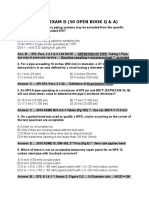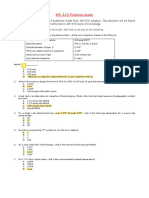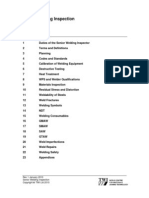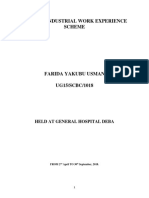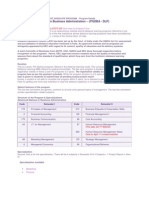1 - 2011 570 Open Book Exam (27Qs)
1 - 2011 570 Open Book Exam (27Qs)
Uploaded by
Sunny ThundilCopyright:
Available Formats
1 - 2011 570 Open Book Exam (27Qs)
1 - 2011 570 Open Book Exam (27Qs)
Uploaded by
Sunny ThundilOriginal Description:
Copyright
Available Formats
Share this document
Did you find this document useful?
Is this content inappropriate?
Copyright:
Available Formats
1 - 2011 570 Open Book Exam (27Qs)
1 - 2011 570 Open Book Exam (27Qs)
Uploaded by
Sunny ThundilCopyright:
Available Formats
Name: ______________________ Badge Number: _____________ Date: March 8, 2011
1. What is the required thickness, given the design conditions below for an existing piping system with a zero corrosion allowance (internally lined)? A) 0.168 inches B) 0.147 inches C) 0.135 inches D) 0.186 inches
Given: Design Pressure & Temperature = 600 psig @ 500F, 10 NPS A-106-B Seamless pipe Show your work in the space provided and include all math steps as shown in class:
2. What is the required thickness, given the same design conditions in question # 1 above utilizing a given Corrosion Allowance of .062 inches (1/16)? A) 0.197 inches B) 0.230 inches C) 0.209 inches D) 0.248 inches
Show your work in the space provided and include all math steps as shown in class: :
3. What is the required thickness (as defined by API 570), given the same design conditions in the question # 1 above and owner/user Engineering structural minimum thickness requirement of .150 inches for NPS 10 piping systems of all Classes? A) 0.147 inches B) 0.150 inches C) 0.168 inches D) None of these
Show your work in the space provided and include all math steps:
Name: ______________________ Badge Number: _____________ Date: March 8, 2011
4. For calculating minimum required thickness for straight pipe under internal pressure, what values are used in the formulas for pressure design thickness & minimum required thickness? A) T = pressure design thickness and t = minimum required thickness B) t = pressure design thickness and T = minimum required thickness C) t m = pressure design thickness and t = minimum required thickness D) t = pressure design thickness and t m = minimum required thickness
5. What is the minimum required thickness of a blank made from ASTM A516 Gr. 60 Plate Material with a with a ring joint design and gasket pitch diameter of 12 inches in a piping system with a design pressure of 400 psi @ 300F? A) .632 inches. B) .756 inches. C) .692 inches D) .734 inches.
Show your work in the space provided and include all math steps:
6. Using the same given design and values as question # 5 above, include a given Corrosion allowance of .125 inches (1/8). What is the required minimum thickness now? A) .757 in. B) .881 in. C) .817 in. D) .859 in.
7. For calculating minimum thickness of a blank, value dg = all of the following except: A) Inside diameter of gasket for raised or flat face flanges B) Inside diameter of gasket for ring joints C) Gasket pitch diameter for ring joints D) Gasket pitch diameter for fully retained gasketed flanges
8. What is the minimum metal temperature exempt from impact testing for API 5L, Grade X-60 seamless pipe having a .750 nominal thickness & having been normalized during manufacture? A) 53F B) 15F C) -20F D) 30F
Name: ______________________ Badge Number: _____________ Date: March 8, 2011
INSTRUCTIONS: THIS PROBLEM COVERS QUESTIONS 9 14 ON THIS PAGE Inspection records contain the following information for thickness measurement location (TML) in an elbow located just outside of a cooling tower flanged connection. Thickness 0.375 @ Baseline UT performed in 2000, 0.350 after 5 years in 2005, and 0.300 after 10 years in 2010. Other Information: The .300 inch thickness is the lowest reading in the piping circuit and showed an increase in loss since the last inspection, due to increased flow velocity, according to the Plant Corrosion Specialist. The required thickness is .200 in. and the piping Circuit was designated as Class 3 for Cooling Water and the 24 NPS line is insulated and adjacent to the cooling tower! 9. On the basis of information above, long-term corrosion rate for the location is: A) 1 mils per year B) 7.5 mils per year C) 10 mils per year D) 15 mils per year.
10. On the basis of information above, short-term corrosion rate for the location is: A) 1 mils per year B) 5 mils per year C) 10 mils per year D) 15 mils per year.
11. On the basis of information above, remaining life of the piping system is: A) 1 years B) 5 years C) 10 years D) 25 years
12. On the basis of information above, half-remaining life of the piping system is: A) 9 months B) 2.5 years C) 5 years D) 12.5 years
13. On the basis of info above, maximum inspection interval of the piping system is: A) 9 months B) 2.5 years C) 5 years D) 10 years
14. The insulation on this 24 NPS line approximately 100 meters long and is damaged in some locations. The Inspector has called for the API 570 recommended % of insulation removal for this condition & total area of insulation = 190 sq. meters. How much insulation will be removed? A) 19 sq. meters B) 1.9 sq. meters C) 47.5 sq. meters D) 4.75 sq. meters
Name: ______________________ Badge Number: _____________ Date: March 8, 2011
15. A piping system designed at 500 psi & 600F is to be hydrostatically tested using the liquid content which is flammable. The pipe material is A-53B Seamless Sch 80 NPS 6. What is the hydrostatic test pressure if the test is conducted at 100F or below? A) 750 psig B) 794 psig C) 812 psig D) 867 psig
Show your work in the space provided and include all math steps:
16. The minimum hold time for a Hydrostatic leak test per ASME B31.3 code is: A) 5 minutes B) 10 minutes C) 15 minutes D) 30 minutes
17. Determine the Corrosion Rate, correct Inspection Interval (from choices given) & MAWP of corroded pipe given the detailed information below and be sure to follow API 570 rules! Design pressure/temp = 500 psig/500F for A106 Gr B Seamless NPS 10 STD wall Pipe, Measured Thickness in 2001 = .360, in 2006 = .330, in 2011 = .300, Corr. Rate = unknown A) Corrosion rate is 6 MPY, the inspection interval = 5 years, and the MAWP = 857 psi B) Corrosion rate is 5 MPY, the inspection interval = 10 years, and the MAWP = 864 psi C) Corrosion rate is 6 MPY, the inspection interval = 5 years, and the MAWP = 844 psi D) Corrosion rate is 6 MPY, the inspection interval = 5 years, and the MAWP = 867 psi
Name: ______________________ Badge Number: _____________ Date: March 8, 2011
18. You are evaluating Charpy impact test results for piping material with a 0.236 in. thickness, and where the largest attainable Charpy V-notch specimen has a width along the notch of 0.157. At what temperature must Charpy testing be conducted? A) Design minimum temperature B) Not higher than design minimum temperature C) 15F below MDMT D) 30F below MDMT
Answer questions 19 through 21 below (PQR Review)
Given: NPS 12 schedule 120 (1.00 in. thick), A-106-C, P No-1, Group 2 (C-Mn-Si Composition) Note: All test results were signed & accepted by Egyptian Mech. Testing Group (Babu B. Babu) Tensile Test specimen # 1 (full size 25mm) Results = 66,500 Failure location = Base metal Tensile Test specimen # 2 (full size 25mm) Results = 69,900 Failure location = Weld metal Guided Bend (side bend) specimen # 1 results = Pass 3 mm slag in the weld area Guided Bend (side bend) specimen # 2 results = Pass 2 mm crack in the weld area Guided Bend (side bend) specimen # 3 results = Pass 3.5 mm incomplete fusion in weld area 19. The two tensile test values provided above were reviewed and found to be: A) Specimen # 1 & 2 are rejectable, both below the required tensile value in ASME IX B) Specimen # 1 is rejectable and # 2 is acceptable as per ASME IX C) Specimen # 1 is acceptable and # 2 is rejectable as per ASME IX D) Specimen # 1 & 2 are acceptable because Babu signed the report
20. The guided bend test results provided above were reviewed and: A) Specimen # 1 & 2 are acceptable, and specimen # 3 is rejectable as per ASME IX B) Specimen # 1 is rejectable, # 2 is acceptable, and # 3 is rejectable as per ASME IX C) Specimen # 1 is acceptable and # 2 is rejectable, and # 3 is acceptable as per ASME IX D) Specimen # 1 is rejectable, and # 2 is acceptable, and # 3 is acceptable as per ASME IX
21. Are the number of tensile test & guided bend test specimens adequate as per ASME IX? A) Yes, Per Table QW-451, the side bends may be substituted for face & root bends B) Yes, because only two specimens are required for each test, given the information above C) Both A & B are correct. The number of specimens is acceptable even if the results are not D) No, because the requirements & notes of Table QW-451 have not been met
Name: ______________________ Badge Number: _____________ Date: March 8, 2011
22. Essential variables are those in which a change, as described in the specific variables, is considered to affect the mechanical properties of the weldment, and shall require requalification of the WPS. Nonessential variables are those in which a change, as described in the specific variables, may be made in the WPS without requalification. All WPS & PQR points must never be left blank (even when a non-essential variable). Supplementary essential variables are: A) Required for metals only when other code Sections specify notch-toughness tests B) In addition to the essential variables for each welding process when impact tests are required C) The same as essential variables, depending upon the welding process utilized D) Both A & B are correct 23. Regarding hole-type Image quality Indicator (IQI) placement & location, IQIs must be placed on the source side of the film. However, where inaccessibility prevents hand placement of IQI(s) on source side, IQI(s) shall be placed on film side in contact with the part being examined. What additional requirements exist regarding this placement of the IQI on the film side? A) Lead letter F shall be placed adjacent to or on IQI(s) B) Lead letter F shall not mask any essential hole where hole type IQIs are used C) Both A & B are correct D) None of the above is correct 24. The code user must have a Quality Program that details how NDE personnel are qualified and
certified. Qualifications must be in accordance with SNT-TC-1A or CP-189. What is meant by the term code user as it relates to a Quality Program for NDE training as per ASME V Code?
A) Manufacturer, fabricator, or Installer performing NDE B) Employer of the NDE personnel C) Any organization conducting NDE to the requirements of ASME V D) None of those listed above 25. What is the essential hole & hole type designation (assume a source side IQI was used) for 4 inch NPS Sch 40 pipe weld in the as welded condition. Apply code rules and use the Table! A) Essential hole is a 2T, with a hole type designation of 10 B) Essential hole is a 2T, with a hole type designation of 12 C) Essential hole is a 2T, with a hole type designation of 15 D) None of the above are acceptable
Name: ______________________ Badge Number: _____________ Date: March 8, 2011
Fig. 328.5.2B Typical Details for Double-Welded Slip-On Flg Attachment Welds 26. What are the minimum required fillet weld sizes (front & back welds) for a double welded slip on flange per Fig.328.5.2B using Detail (1), given a 3 NPS Sch 40 pipe & class 150 rated slip-on welding flange? A) 5.6 mm for the front weld (ID) & 8.6 mm for the back weld (OD) B) 6.0 mm for the front weld (ID) & 7.8 mm for the back weld (OD) C) 6.0 mm for the front weld (ID) & 6.0 mm for the back weld (OD) D) 5.6 mm for the front weld (ID) & 7.8 mm for the back weld (OD)
Show your work in the space provided and include all math steps:
27. What is the minimum required fillet weld size for a socket weld on a NPS 1 Sch 160 Seamless A-106 Gr B pipe, design @ 750 psi & 400F? (Fig.328.5.2C of ASME B31.3) A) .024 inches B) .130 inches
Solve for t Show
C) .187 inches
D) .125 inches
your work in the space provided and include all math:
You might also like
- API-570 Final Exam QuestionsDocument26 pagesAPI-570 Final Exam QuestionsAndiappan Pillai88% (26)
- 5 - API 570 Exam 100 QDocument23 pages5 - API 570 Exam 100 QSunny Thundil100% (11)
- 5 - API 570 Exam 100 QDocument23 pages5 - API 570 Exam 100 QSunny Thundil100% (11)
- API 570 Final Exam ClosedDocument12 pagesAPI 570 Final Exam Closedtbmari100% (3)
- API 570 Final Exam Open Book Questions 24Document11 pagesAPI 570 Final Exam Open Book Questions 24Ravindra S. Jivani100% (5)
- API 570 Final Practice ExamDocument23 pagesAPI 570 Final Practice ExamAndiappan PillaiNo ratings yet
- API 570 Atual Exam 2015Document38 pagesAPI 570 Atual Exam 2015أحمد صبحى100% (4)
- 1 API 570 Bench Mark Quiz 1 55Document56 pages1 API 570 Bench Mark Quiz 1 55rodholfho100% (1)
- API 570 Mock Exam Closed BookDocument17 pagesAPI 570 Mock Exam Closed Bookaasatti100% (1)
- Test - API 577 - 9 Quizlet PDFDocument2 pagesTest - API 577 - 9 Quizlet PDFAnonymous Q4YUvR100% (2)
- API 570 Certification PreparationDocument1 pageAPI 570 Certification Preparationmcjeff32No ratings yet
- API 510 Mathematical CalculationsDocument26 pagesAPI 510 Mathematical Calculationsglazetm100% (1)
- Kanji Master N4 PDF Free - : DownloadDocument2 pagesKanji Master N4 PDF Free - : DownloadChad Wick0% (3)
- 3 - 2011 570 Answers (27 75 102)Document22 pages3 - 2011 570 Answers (27 75 102)Sunny Thundil100% (2)
- API-570-Exam-100-Q (계산문제 정리할수 있는 문제) PDFDocument23 pagesAPI-570-Exam-100-Q (계산문제 정리할수 있는 문제) PDFasNo ratings yet
- API 570-Final Model Exam-Open Book Without AnswersDocument6 pagesAPI 570-Final Model Exam-Open Book Without Answersbanana100% (1)
- API 570 Libro Abierto GeneralDocument26 pagesAPI 570 Libro Abierto GeneralWveimar BriceñoNo ratings yet
- 510 IRS Pune Open Book Questions FinalDocument6 pages510 IRS Pune Open Book Questions Finaljaheer1No ratings yet
- API-510 Exam # 3 2008 Open Book Exam PDFDocument14 pagesAPI-510 Exam # 3 2008 Open Book Exam PDFIslam FawzyNo ratings yet
- FINAL EXAMINATION API 570 Open BookDocument3 pagesFINAL EXAMINATION API 570 Open BookdenarlijeronNo ratings yet
- API 570 ExamDocument33 pagesAPI 570 ExammedhichemguesmiNo ratings yet
- A) 1.7 To 4.0 B) 2.55 To 3.9 C) 2.0 To 4.0 D) None of TheseDocument17 pagesA) 1.7 To 4.0 B) 2.55 To 3.9 C) 2.0 To 4.0 D) None of TheseAshish Patel100% (1)
- API 510 Final Model Exam-Open Book Page 1 of 6Document6 pagesAPI 510 Final Model Exam-Open Book Page 1 of 6jay2kay5793No ratings yet
- Non-Destructive Evaluation of Corrosion and Corrosion-assisted CrackingFrom EverandNon-Destructive Evaluation of Corrosion and Corrosion-assisted CrackingRaman SinghNo ratings yet
- API 570 Final Exam Close Book Questions 23Document10 pagesAPI 570 Final Exam Close Book Questions 23Ravindra S. Jivani100% (1)
- 510 Open Exam B. Rev7Document15 pages510 Open Exam B. Rev7yrdna nawaiteosNo ratings yet
- 2 - 2011 570 Closed Book Exam (75Qs)Document15 pages2 - 2011 570 Closed Book Exam (75Qs)Sunny Thundil100% (3)
- API 510 CB Mockup 3 R0 26112010Document18 pagesAPI 510 CB Mockup 3 R0 26112010essnelsonNo ratings yet
- Api 510Document7 pagesApi 510Ranaweera AriyamanjulaNo ratings yet
- Study Guide For 2013 API 570 ExamsDocument17 pagesStudy Guide For 2013 API 570 Examsapply19842371100% (1)
- API 570 Closed Book 6 Exam QuestionsDocument21 pagesAPI 570 Closed Book 6 Exam QuestionsFares ÆazizNo ratings yet
- API 510 Closed 5Document5 pagesAPI 510 Closed 5Einsteinw2No ratings yet
- Closed Book Api 572-A (55-65) - 2Document11 pagesClosed Book Api 572-A (55-65) - 2slxanto100% (1)
- API 570 - Refresh - CB - 18 June 2014Document14 pagesAPI 570 - Refresh - CB - 18 June 2014nathan zacky ardamaNo ratings yet
- API 570 Questions 10Document5 pagesAPI 570 Questions 10Ravindra S. JivaniNo ratings yet
- 17 Multiple Choice QuestionsDocument3 pages17 Multiple Choice QuestionsAnonymous Q4YUvR100% (1)
- Final Examination #1: Open Book Questions (1 50)Document29 pagesFinal Examination #1: Open Book Questions (1 50)kiho sung100% (1)
- Api 510 QDocument25 pagesApi 510 QShyam Singh100% (1)
- API 570 Model Questions-1 PDFDocument4 pagesAPI 570 Model Questions-1 PDFabdulgafoor54No ratings yet
- API 570 Questions 09 API-571-577Document5 pagesAPI 570 Questions 09 API-571-577Ravindra S. JivaniNo ratings yet
- API 570 Questions 12Document5 pagesAPI 570 Questions 12Ravindra S. JivaniNo ratings yet
- API 570 Bench Mark Quiz (1-55)Document56 pagesAPI 570 Bench Mark Quiz (1-55)Christopher Randolph100% (5)
- API 570 - Mockup OP - Paper 2 + MDocument13 pagesAPI 570 - Mockup OP - Paper 2 + MShanawas Abdul Razak80% (5)
- API 570 Practice Questions (Numbers Only) All Questions Are Closed BookDocument5 pagesAPI 570 Practice Questions (Numbers Only) All Questions Are Closed BookNuwan RanaweeraNo ratings yet
- API 653 PC 15may04 Exam 4 ClosedDocument5 pagesAPI 653 PC 15may04 Exam 4 ClosedShaalan AliNo ratings yet
- API 570 Questions 19Document4 pagesAPI 570 Questions 19Ravindra S. Jivani100% (1)
- API 653 - Section 650 Flashcards - QuizletDocument6 pagesAPI 653 - Section 650 Flashcards - Quizletام يمنى ايمنNo ratings yet
- API 570 DemoDocument6 pagesAPI 570 Demojaire esparza100% (1)
- Fareed-STS) API 570 DAY 5Document137 pagesFareed-STS) API 570 DAY 5Ashish Patel100% (2)
- Closed & Open API 570 ExamDocument22 pagesClosed & Open API 570 ExammazpriNo ratings yet
- 1.510 Sample QuestionSDocument7 pages1.510 Sample QuestionSvamsikrishnaNo ratings yet
- Api 510 Close Book (Sec Viii & 510) - 17Document12 pagesApi 510 Close Book (Sec Viii & 510) - 17walid walid100% (1)
- Api 510 Preparatory Final Exam (Closed Book) : Answers in A Separate Answer SheetDocument14 pagesApi 510 Preparatory Final Exam (Closed Book) : Answers in A Separate Answer SheetCss Sfaxien100% (1)
- API 570 Mock Up Closed Book Questions 25Document18 pagesAPI 570 Mock Up Closed Book Questions 25Ravindra S. Jivani100% (1)
- BABU - 570 Exam QuestionsDocument4 pagesBABU - 570 Exam QuestionsSunny Thundil100% (1)
- Examination Question 510Document12 pagesExamination Question 510ohengjkt100% (1)
- Api 578-Mock 1Document27 pagesApi 578-Mock 1sheikmoin100% (1)
- API 570 Questions 07Document20 pagesAPI 570 Questions 07Ravindra S. Jivani100% (1)
- API 653 Practice Exam Q A 2012 PDFDocument32 pagesAPI 653 Practice Exam Q A 2012 PDFAntony Bruno GenewinNo ratings yet
- 177538089-API-570-Final-Exam-Questions - REALIZARDocument26 pages177538089-API-570-Final-Exam-Questions - REALIZARALe Infinito100% (2)
- Api 570 Final Practice ExamDocument23 pagesApi 570 Final Practice ExamCong BuiNo ratings yet
- 2 - API 570 Exam B (150 Q&A)Document33 pages2 - API 570 Exam B (150 Q&A)Dabbar Taher100% (1)
- 5 - API 570 Exam 100 QsDocument25 pages5 - API 570 Exam 100 QsSunny Thundil88% (32)
- 2 - 2011 570 Closed Book Exam (75Qs)Document15 pages2 - 2011 570 Closed Book Exam (75Qs)Sunny Thundil100% (3)
- BABU - 570 Exam QuestionsDocument4 pagesBABU - 570 Exam QuestionsSunny Thundil100% (1)
- Unit PacketDocument3 pagesUnit Packetapi-210735274No ratings yet
- Structural Mechanics 3 - ENG3047Document5 pagesStructural Mechanics 3 - ENG3047Franciscodias69No ratings yet
- General-Supervision-File-Review-Checklist 2Document3 pagesGeneral-Supervision-File-Review-Checklist 2api-389758204No ratings yet
- Research Proposal An ExampleDocument2 pagesResearch Proposal An ExampleAnamKhanNo ratings yet
- ALCPT Handbook PDFDocument16 pagesALCPT Handbook PDFMedina Mališević100% (1)
- Robin 3rd Periodical Exam Gr. 4 - 6Document10 pagesRobin 3rd Periodical Exam Gr. 4 - 6Miriam VillegasNo ratings yet
- Ecz Services PDFDocument3 pagesEcz Services PDFDøps MaløneNo ratings yet
- DAC Requirements For ISO 17020Document25 pagesDAC Requirements For ISO 17020Steve Morrison100% (4)
- Writing AbstractDocument3 pagesWriting AbstractTiara Eka PutriNo ratings yet
- Nutrition & Dietetics (Dietician) Careers - Courses, Jobs & SalaryDocument10 pagesNutrition & Dietetics (Dietician) Careers - Courses, Jobs & SalaryPrakash Chavan0% (1)
- 1.analog System - Gateacademy-2020) PDFDocument53 pages1.analog System - Gateacademy-2020) PDFRhitesh Kumar SinghNo ratings yet
- NbgnhsfhbhvgfgwannaoneDocument121 pagesNbgnhsfhbhvgfgwannaoneDessa Dean0% (1)
- KomDocument9 pagesKomaravind SinganagariNo ratings yet
- Eng231 Course SyllabusDocument4 pagesEng231 Course SyllabusAsma R. El KawafiNo ratings yet
- A Framework For Reflective Writing - Jenny MoonDocument2 pagesA Framework For Reflective Writing - Jenny MoonM. FurqonNo ratings yet
- CSWIP 3.2-2010 WIS10 Senior Welding InspectionDocument302 pagesCSWIP 3.2-2010 WIS10 Senior Welding Inspectionapply19842371100% (9)
- Membership Rules For Titles Grades PDFDocument30 pagesMembership Rules For Titles Grades PDFKamal DeshapriyaNo ratings yet
- Comparison of The Education System in The Caribbean and Finland.Document17 pagesComparison of The Education System in The Caribbean and Finland.marie2edwards100% (1)
- Art of Questioning and Test Construction Presentation-JSCDocument60 pagesArt of Questioning and Test Construction Presentation-JSCEdison C. TiczonNo ratings yet
- 27 Thesis MilestonesDocument5 pages27 Thesis MilestonesProfessionalPaperWriterCanada100% (1)
- REVIEW CHECKLIST (To Be Filled by Principal Investigator (PI) )Document3 pagesREVIEW CHECKLIST (To Be Filled by Principal Investigator (PI) )Farawaheeda Shukor0% (1)
- IT Report by Farida Yakubu UsmanDocument36 pagesIT Report by Farida Yakubu Usmanmamudu francisNo ratings yet
- CEE 153 15 SyllabusDocument2 pagesCEE 153 15 SyllabusParisa BNo ratings yet
- Position Paper On House Bill No. 10234Document6 pagesPosition Paper On House Bill No. 10234Erika GonzalesNo ratings yet
- Post-Graduate Diploma in Business Administration - (PGDBA - DLP)Document3 pagesPost-Graduate Diploma in Business Administration - (PGDBA - DLP)Emmanuel AyetteyNo ratings yet
- Doglapan The Hard Truth About Life and Start UpsDocument163 pagesDoglapan The Hard Truth About Life and Start Upspreyaskamghosal2006No ratings yet
- 2019 CBET Exam App 071819Document4 pages2019 CBET Exam App 071819Usama HassanNo ratings yet
- Hindi: Paper 3195/01 CompositionDocument4 pagesHindi: Paper 3195/01 Compositionmstudy123456No ratings yet
- Entrance Exam Calender 2023 (Student Copy)Document2 pagesEntrance Exam Calender 2023 (Student Copy)Sriram NandulaNo ratings yet





